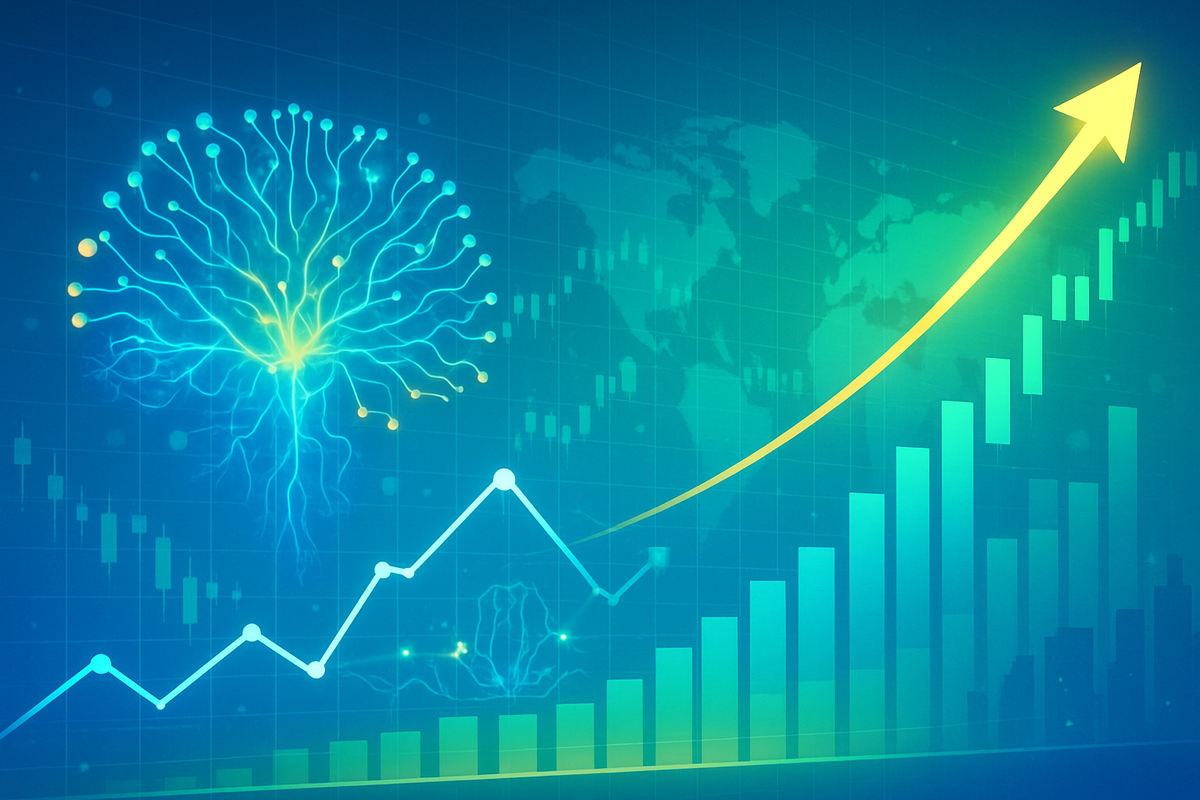
The global stock market has orchestrated a stunning comeback rally as of October 2025, with major indices reaching new highs and adding trillions in market value. This impressive rebound, characterized by a potent mix of artificial intelligence (AI) enthusiasm and expectations of continued monetary easing from the Federal Reserve, has ignited a "risk-on" sentiment among investors. However, beneath the surface of soaring valuations and widespread optimism, concerns linger regarding market concentration, geopolitical tensions, and the sustainability of the current growth trajectory.
This powerful rally has seen the S&P 500 index surge by an estimated 83% since its official bull market inception on October 12, 2022, culminating in a remarkable 35% climb since its most recent low on April 8, 2025. This rapid ascent, one of the fastest on record, follows an earlier period of market jitters largely fueled by President Donald Trump's initial tariff war threats. The immediate implication is a significant boost in investor confidence, though tempered by a cautious eye on potential headwinds.
Rally's Ascent: A Deep Dive into the Market's Resurgence
The current market resurgence is a multifaceted phenomenon, intricately woven with technological innovation, central bank policy, and robust corporate performance. The S&P 500's journey from its April 2025 low to its current elevated state underscores a period of intense buying activity and shifting investor priorities.
At the heart of this rally lies an almost insatiable investor appetite for all things related to Artificial Intelligence. The Nasdaq 100, heavily weighted with technology giants, has seen an astonishing surge of over 50% year-to-date from its lowest point, consistently reaching all-time highs. This AI mania has propelled several key players to unprecedented gains, including Micron Technology (NASDAQ: MU) with a 91% increase, Palantir (NYSE: PLTR) soaring by 140%, Broadcom (NASDAQ: AVGO) up 120%, and Nvidia (NASDAQ: NVDA) registering a formidable 92% gain. Technology and Communication Services sectors were the clear frontrunners in September 2025, each posting gains of 7% and 6% respectively, solidifying their role as primary drivers of the market's upward momentum.
Complementing the AI narrative is the Federal Reserve's accommodative stance on interest rates. Following a 25-basis point rate cut in September 2025, the market is now pricing in expectations for two additional reductions before the year's end. This dovish monetary policy has created a favorable environment for equities, encouraging investors to rotate out of lower-yielding assets and into higher-return opportunities. Furthermore, corporate earnings have displayed remarkable resilience, with analysts forecasting a robust 7.2% year-over-year rise in S&P 500 profits for the third quarter of 2025. This marks the ninth consecutive quarter of earnings growth and the third-highest pre-season forecast in four years, demonstrating the underlying strength of corporate America.
Initial market reactions to these developments have been largely positive, albeit with intermittent bouts of volatility. While the S&P 500 enjoyed a "strikingly calm" period of 119 trading days without a 2% pullback, and the CBOE Volatility Index (VIX) plumbed historic lows, recent geopolitical developments have introduced turbulence. President Trump's renewed threats of tariffs, specifically a 25% tariff on medium- and heavy-duty trucks starting November 1, following earlier threats on Chinese imports, triggered immediate sell-offs across global markets. However, subsequent softening of rhetoric often led to rapid rebounds, illustrating the market's sensitivity to trade news and its underlying bullish bias. Global participation has also been a hallmark of this rally, with nearly 80% of 60 tracked global stock markets rising at least 10%, and emerging markets experiencing their best rally in over 15 years, with the MSCI Emerging Markets index up 30% year-to-date. Gold has also surged, hitting record highs above $4,000 per ounce, reflecting both safe-haven demand and diversification from the U.S. dollar.
Companies on the Rise and Facing Challenges in the New Market Landscape
The stock market's comeback rally has created clear winners and losers, reshaping the competitive landscape and forcing strategic adaptations across various industries. The concentrated nature of the rally, particularly in the technology sector, means that companies deeply embedded in the AI ecosystem are reaping substantial rewards, while others face increased pressure to innovate or risk being left behind.
The most prominent beneficiaries are undoubtedly the technology behemoths and semiconductor companies driving the AI revolution. Companies like Nvidia (NASDAQ: NVDA), a leader in AI chips, and Broadcom (NASDAQ: AVGO), a diversified semiconductor and infrastructure software company, have seen their valuations skyrocket. Their strong earnings reports and optimistic outlooks on AI demand have made them investor darlings. Similarly, software and data analytics firms like Palantir (NYSE: PLTR), which leverages AI for complex data analysis, and memory chip maker Micron Technology (NASDAQ: MU), essential for AI infrastructure, have experienced explosive growth. These companies are not only benefiting from direct sales of AI-related products and services but also from the broader market's confidence in their future growth prospects, attracting significant capital inflows.
Conversely, companies that are slow to adopt AI or those in traditional sectors facing headwinds from higher input costs or shifting consumer preferences might find themselves struggling. While not explicitly identified as "losers" in the research, the concentration of the rally suggests that sectors and companies not directly tied to the AI narrative or benefiting from lower interest rates might see their relative market performance lag. Furthermore, companies with significant exposure to international trade, particularly those involved in industries targeted by President Trump's tariff threats (e.g., manufacturers of medium- and heavy-duty trucks), could face increased operational costs, reduced demand, and disrupted supply chains. This could impact their profitability and investor sentiment.
The rally's impact extends beyond direct gains and losses, influencing strategic decisions. Many companies across all sectors are now compelled to accelerate their AI integration strategies to remain competitive, leading to increased R&D spending and potential mergers and acquisitions in the AI space. For example, traditional financial institutions might invest heavily in AI to improve efficiency and customer service, while retail companies could leverage AI for personalized marketing and supply chain optimization. The high valuations in the tech sector also make it challenging for smaller, innovative AI startups to compete for talent and resources, potentially leading to consolidation or acquisition by larger players. The ongoing federal government shutdown, by depriving markets of crucial U.S. economic data, also creates an environment of uncertainty that could disproportionately affect companies reliant on stable economic conditions or government contracts.
Broader Implications: A Shifting Economic and Regulatory Landscape
The stock market's dramatic comeback rally is more than just a financial event; it signals profound shifts in broader industry trends, potential ripple effects across the economy, and evolving regulatory considerations. This current market cycle, heavily influenced by technological disruption and monetary policy, bears both unique characteristics and echoes of historical precedents.
One of the most significant broader industry trends highlighted by this rally is the accelerating dominance of artificial intelligence. AI is not merely a sector but a transformative technology impacting nearly every industry. Companies that effectively integrate AI into their operations, product development, and customer engagement are poised for significant competitive advantages, while those that lag risk obsolescence. This widespread adoption is creating new ecosystems of AI service providers, data management solutions, and specialized hardware, leading to a re-evaluation of business models across the board. The rally underscores a fundamental belief among investors that AI will drive the next wave of productivity and innovation.
The ripple effects of this concentrated rally are substantial. The heavy reliance on a few tech behemoths—the ten largest companies in the S&P 500 now account for 40.6% of the SPDR S&P 500 ETF Trust, the highest level since at least 1972—raises concerns about market fragility. A downturn in these dominant players could have disproportionately negative consequences for the broader market. Smaller companies, particularly those outside the AI and tech sphere, might struggle to attract investment, potentially exacerbating economic disparities. Furthermore, the robust performance of emerging markets, driven by a weakening U.S. dollar and AI prospects, suggests a potential rebalancing of global economic power, with new investment opportunities arising in previously overlooked regions.
Regulatory and policy implications are also coming into sharper focus. The "AI hype" has prompted warnings from figures like Jeff Bezos about a potential "industrial bubble," which could attract increased scrutiny from financial regulators. Concerns about antitrust issues related to the dominance of a few tech giants are likely to intensify, potentially leading to stricter oversight or even breakup calls. Moreover, the Federal Reserve's ongoing interest rate policies will continue to be a critical factor, with every rate decision impacting borrowing costs, corporate investments, and consumer spending. Geopolitical tensions, particularly renewed U.S.-China trade disputes and their tariff implications, remain a significant wildcard, capable of disrupting global supply chains and dampening investor sentiment. The ongoing federal government shutdown further complicates the economic outlook, as it deprives markets of crucial data needed for informed decision-making.
Historically, periods of rapid technological advancement and market concentration have often been followed by periods of correction or increased regulation. Comparisons might be drawn to the dot-com bubble of the late 1990s, though proponents argue that today's AI advancements are backed by more tangible technological capabilities and revenue streams. Nevertheless, the rapid increase in valuations for AI-linked stocks warrants careful consideration of past market excesses and their eventual unwinding. The current rally’s global participation, particularly in emerging markets, distinguishes it from some past U.S.-centric booms, suggesting a broader, interconnected financial landscape.
The Road Ahead: Navigating Opportunities and Challenges
As the stock market continues its impressive rally, the path forward presents a blend of exciting opportunities and significant challenges. Investors, policymakers, and businesses alike must carefully navigate this evolving landscape, anticipating both short-term fluctuations and long-term strategic shifts.
In the short term, the market's trajectory will likely remain highly sensitive to Federal Reserve policy and geopolitical developments. Further interest rate cuts, as currently anticipated, could provide additional tailwinds for equities, particularly growth stocks. However, any unexpected hawkish turns from the Fed or escalation of trade tensions, such as more extensive tariffs, could trigger immediate volatility and market pullbacks. The upcoming Q3 bank earnings reports will be crucial for gauging the health of the broader economy, especially in the absence of complete U.S. economic data due to the government shutdown. Investors should prepare for continued market concentration, with AI-linked tech stocks potentially leading further gains, but also be mindful of increasing valuation concerns.
Looking further ahead, the long-term possibilities are largely shaped by the continued development and widespread adoption of AI. Companies that successfully integrate AI into their core operations, fostering efficiency and innovation, are positioned for sustained growth. This will necessitate significant strategic pivots and adaptations across industries, including increased investment in AI research and development, workforce retraining, and the development of new business models. Market opportunities will emerge in areas such as specialized AI hardware, advanced software solutions, cybersecurity for AI systems, and ethical AI development. However, challenges will also arise, including managing the ethical implications of AI, addressing potential job displacement, and ensuring equitable access to AI technologies. The "easy money" in AI stocks may have already been made, suggesting that future gains might require more discerning investment strategies.
Potential scenarios and outcomes for the market vary widely. A "soft landing" scenario, where inflation is controlled, interest rates stabilize at lower levels, and AI drives productivity gains without significant economic disruption, could see the bull market extend well into 2026. Conversely, a "hard landing" scenario, triggered by an aggressive Fed, a prolonged government shutdown, or a full-blown trade war, could lead to a significant market correction. Another possibility is a "two-speed market," where a select group of AI-driven companies continues to outperform, while the rest of the market struggles with slower growth and higher capital costs. Companies that adapt swiftly to these scenarios, perhaps through diversification, strategic partnerships, or enhanced risk management, will be better positioned to thrive.
Conclusion: A Market Transformed, Cautious Optimism Prevails
The stock market's comeback rally of 2025 represents a significant turning point, underscoring the profound impact of technological innovation and monetary policy on global financial markets. From its origins in late 2022, accelerating dramatically in 2025, this rally has not only restored investor confidence but also reshaped market dynamics, with artificial intelligence emerging as the undisputed kingmaker.
Key takeaways from this period include the unparalleled influence of AI on market valuations, the Federal Reserve's critical role in fostering a "risk-on" environment through anticipated rate cuts, and the impressive resilience of corporate earnings. The rally's global reach, particularly its strong showing in emerging markets, highlights a broadening base of economic optimism. However, the high concentration of market gains in a few dominant tech companies, alongside persistent geopolitical trade tensions and domestic political uncertainties, serves as a crucial reminder of underlying fragilities.
Moving forward, the market is poised for continued evolution. While the immediate outlook remains cautiously optimistic, driven by the powerful combination of AI potential and supportive monetary policy, investors must remain vigilant. The specter of stretched valuations, particularly in the AI sector, warrants careful consideration, with some experts warning of a potential "industrial bubble." The ongoing U.S.-China trade relationship and the Federal Reserve's future policy decisions will be paramount in determining the market's trajectory.
Investors should watch closely for further developments in AI technology and its real-world applications, signs of broadening market participation beyond the dominant tech giants, and any shifts in central bank rhetoric. Monitoring corporate earnings reports for signs of sustained growth and carefully assessing geopolitical headlines will be essential in navigating the coming months. The market has proven its capacity for remarkable resilience and growth, but prudence and adaptability will be key to capitalizing on its opportunities while mitigating its inherent risks.
This content is intended for informational purposes only and is not financial advice





